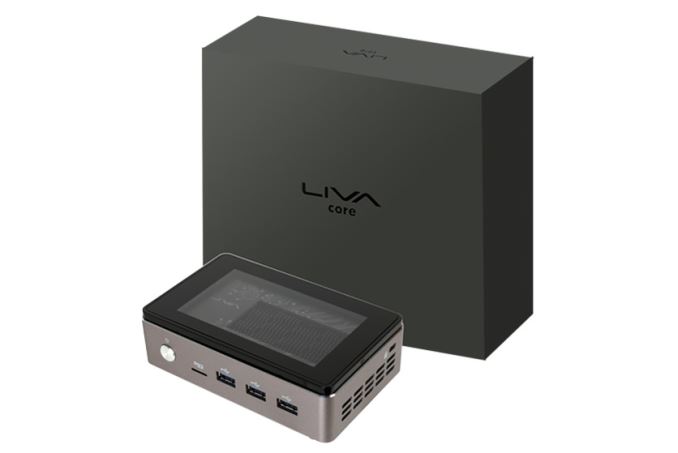ECS LIVA Core Review: A Fanless Core M mini-PC
by Ganesh T S on October 7, 2015 8:00 AM ESTFinal Words
The ECS LIVA Core provided us with the opportunity to evaluate Core M in a desktop PC configuration. Compact fanless PCs that can be VESA-mounted on the back of a display are understandably popular, and the LIVA class of products from ECS caters to this market segment as an alternative to the standard NUCs. With the addition of the LIVA Core, ECS has two different performance levels for customers to choose from. Within the same power envelop, we have the LIVA Core providing with tangible performance improvements compared to the LIVA X2. Obviously, there is a price premium associated with this performance increase. The presence of two HDMI outputs can also lead to some interesting use-cases.
In terms of scope for improvement, ECS could have gone for DRAM with better timings. For example, in our Zotac ZBOX CI540 nano review, we used DDR3L memory with 9-9-9-24 timing. The soldered memory in the LIVA Core is rated for 11-11-11-28. This definitely leaves some performance on the table (as we saw the CI540 nano perform as good or even better than the LIVA Core in a few benchmarks). On the I/O front, the microSD slot should definitely be replaced with a full-sized SDHC slot (one should note that microSD cards can be used in those with a passive adapter, but the reverse situation is not possible). Given the premium nature of the system, it would have been nice to have an Intel LAN chipset instead of the currently integrated Realtek LAN. We are also not very enthusiastic about the SandForce-based SSD choice. Consumers wishing to upgrade the SSD need to note that only M.2 2280 SSDs are supported. The thermal solution for the SSD also needs to be kept in mind, given its proximity to the WLAN component.
The thermal solution seems fine at first glance. It should allow for more than acceptable performance under normal client workloads. However, we believe the chassis design could be altered for better airflow and convective cooling. A design similar to that of the Zotac C-series nano units (with perforations all around, including the top) could help with this aspect.
ECS has plans for two SKUs in the NA market. The configuration we reviewed comes in at $453. Another SKU with the same hardware configuration, but a licensed pre-installed version of Windows 10 Home will come in at $553.
Coming to the business end of the review, it can be said that the ECS LIVA Core comes in a slick package with acceptable trade-offs. However, the premium pricing of the unit may be considered as a deterrent by many prospective customers. That said, one should note that passively cooled PCs with similar or better performance carry a larger premium. For example, the Haswell-Y-based Zotac ZBOX CI540 nano configuration that was used as a comparison point in many of the benchmarks comes in at $520.
Core M is a great fit for fanless 2-in-1s. However, in a desktop form factor, we believe consumers might be more attracted to the cheaper Braswell-based fanless PCs or opt to sacrifice the looks and form factor a bit, pay a premium and go for the fanless NUCs. It will be interesting to see the market reception for Core M-based fanless desktop PCs such as the ECS LIVA Core that occupy a price point in the middle.











35 Comments
View All Comments
solarrocker - Wednesday, October 7, 2015 - link
Uhm, 4 x 8 Gb (4 GB)?Is my Dyslexia affecting my math now as well...
Tobol - Wednesday, October 7, 2015 - link
8 Gb == 1 GB so I guess 4 x 1 GB = 4GB is correctsolarrocker - Wednesday, October 7, 2015 - link
True, didn't notice the lowercase b.Why are they even writing it like that, haven't seen such a notation for RAM in, well, ever. Or is this common practice now?
Stuka87 - Wednesday, October 7, 2015 - link
Memory is technically always measured in bits (and thereby noted megabit, gigabit, terabit, etc). Its just simplified for the masses into gigabytes.LoganPowell - Friday, November 27, 2015 - link
Not my first choice for a desktop. The ECS Liva core does not even made it to consumer based rankings (see http://www.consumerrunner.com/top-10-best-desktops... for example...)mctylr - Wednesday, October 7, 2015 - link
Individual RAM ICs are measured in bits, whereas RAM modules are measured in both bits or bytes, depending on the audience.solarrocker - Wednesday, October 7, 2015 - link
Thanks, guess I never really looked at it that way.wffurr - Wednesday, October 7, 2015 - link
8 Gigabits (Gb) is 1 Gigabyte (GB). So 4 X 8 Gb is indeed 4 GB.harpocrates - Wednesday, October 7, 2015 - link
32 Gigabits is equal to 4 gigabyte. So in this case the ram uses four 8 gigabit chips to get to 32 gigabits in total. The Gb vs GB nomenclature is not very clear is it?Vepsa - Wednesday, October 7, 2015 - link
I wouldn't say that it isn't clear, its just that most people don't know they are different which is sad IMHO.